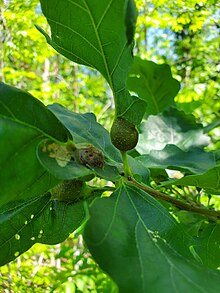pms
nòm ant ël fil

Andricus quercuspetiolicola, also called the oak petiole gall wasp, is a species of oak gall wasp in the family Cynipidae.[1] Galls in which the larvae live and feed are formed along the midrib or petiole of white oak leaves.[1]
This species occurs throughout the eastern half of North America where its host plants grow.[1][2][3][4]

The oak petiole gall wasp forms galls on white oaks, including Quercus alba, Q. bicolor, Q. montana, Q. macrocarpa, Q. michauxii, Q. prinoides, and Q. stellata.[1][2]
The galls of the sexual generation are round or club-shaped and formed on the petiole or midrib of the leaves in spring, with adults of both sexes emerging from galls in late June and early July.[1][2] The gall is a firm swelling with a scar at the apex and contains several cells, each with a larva.[1][2] It is initially green but becomes brown and woody as it ages.[1][2][5]
The galls and timing of the agamic generation are unknown.[3]
Parasitoids of the oak petiole gall wasp include the crypt-keeper wasp (Euderus set).[6]
The adults were first described by Homer Franklin Bassett in 1863 with the name Cynips quercuspetiolicola, though the galls had been previously described by Carl Robert Osten-Sacken.[5] This species is now considered to be in the genus Andricus, and several other names are considered synonyms.[7]
Andricus quercuspetiolicola, also called the oak petiole gall wasp, is a species of oak gall wasp in the family Cynipidae. Galls in which the larvae live and feed are formed along the midrib or petiole of white oak leaves.